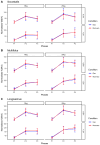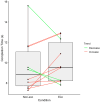Biomechanical Effects of a Passive Back-Support Exosuit During Simulated Military Lifting Tasks-An EMG Study
- PMID: 40432003
- PMCID: PMC12115597
- DOI: 10.3390/s25103211
Biomechanical Effects of a Passive Back-Support Exosuit During Simulated Military Lifting Tasks-An EMG Study
Abstract
Military operators performing vehicle maintenance work are at times subject to onerous tasks such as lifting and transporting heavy loads, potentially in confined spaces. As this presents a risk for developing musculoskeletal injury, it is of interest to evaluate if a passive back-support exosuit could help reduce back muscle load. This study used wireless electromyographic (EMG) sensors to evaluate the biomechanical effects of exosuits during lifting tasks. Ten male participants performed military-relevant lifting tasks with and without wearing the exosuit in randomised orders. The lifting tasks included (1) vertical lifts of different weights (15 and 25 kg) onto different platform heights (0.5 m and 1.2 m) and (2) a lateral walk task across 4 m in a confined space while carrying a 39 kg weight. EMG activities of three back muscle groups (longissimus, iliocostalis, and multifidus) were measured and normalised to maximal isometric back extension tasks. The results showed no significant differences in muscle activation between conditions in most lifting tasks, except for a reduction in longissimus muscle activity when using the exosuit during lateral walking. Individual responses varied substantially, with some participants showing reduced muscle activity, while others did not. These findings highlight the challenges in implementing exosuits in reducing back muscle load during military lifting tasks. While passive back-support exosuits may provide benefits to some users, their effectiveness varies among individuals and may be task-dependent.
Keywords: Auxivo; electromyography; exoskeleton; load; muscle activity; spine.
Conflict of interest statement
The authors declare no conflicts of interest.
Figures











Similar articles
-
Effects on muscular activity and usability of soft active versus rigid passive back exoskeleton during symmetric lifting tasks.Sci Rep. 2025 Aug 14;15(1):29839. doi: 10.1038/s41598-025-14500-3. Sci Rep. 2025. PMID: 40813418 Free PMC article.
-
Musculoskeletal models determine the effect of a soft active exosuit on muscle activations and forces during lifting and lowering tasks.J Biomech. 2024 Nov;176:112322. doi: 10.1016/j.jbiomech.2024.112322. Epub 2024 Sep 11. J Biomech. 2024. PMID: 39305855
-
Effects of a back-assist exosuit in lab-based approximations of construction tasks performed by novices and experienced construction workers.Ergonomics. 2025 Feb;68(2):267-284. doi: 10.1080/00140139.2024.2325535. Epub 2024 Mar 5. Ergonomics. 2025. PMID: 39387502
-
Evaluation of the HeroWear Apex back-assist exosuit during multiple brief tasks.J Biomech. 2021 Sep 20;126:110620. doi: 10.1016/j.jbiomech.2021.110620. Epub 2021 Jul 9. J Biomech. 2021. PMID: 34293602 Free PMC article.
-
Short-term effects of the Auxivo LiftSuit during lifting and static leaning.Appl Ergon. 2022 Jul;102:103765. doi: 10.1016/j.apergo.2022.103765. Epub 2022 Apr 8. Appl Ergon. 2022. PMID: 35405455
References
-
- Ministry of Manpower . Workplace Safety and Health Report 2021. Ministry of Manpower; Singapore: 2022. [(accessed on 15 February 2025)]. Available online: https://www.mom.gov.sg/workplace-safety-and-health/wsh-reports-and-stati....
MeSH terms
LinkOut - more resources
Full Text Sources
Medical
Research Materials

